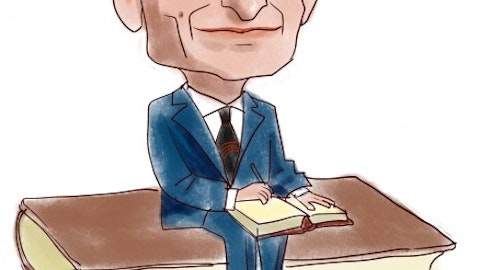ASE Technology Holding Co., Ltd. (NYSE:ASX) Q3 2023 Earnings Call Transcript October 26, 2023
Ken Hsiang: Hello, I am Ken Hsiang, the Head of Investor Relations for ASE Technology Holdings. Welcome to our Third Quarter 2023 Earnings Release. Thank you for attending our conference call today. Please refer to our safe harbor notice on Page 2. All participants consent to having their voices and questions broadcast via participation in this event. If participants do not consent, please disconnect at this time. I would like to remind everyone that the presentation that follows may contain forward-looking statements. These forward-looking statements are subject to a high degree of risk and our actual results may differ materially. For the purposes of this presentation, dollar figures are generally stated in new Taiwan dollars, unless otherwise indicated.
As a Taiwan-based company, our financials are presented in accordance with Taiwan IFRS. Results presented using Taiwan IFRS may differ materially from results using other accounting standards, including those presented by our subsidiary using Chinese GAAP. I am joined today by Joseph Tung, our CFO. For today’s session, I will be giving the prepared remarks. Joseph will then be available to take your questions during the Q&A session that follows. The overall environment for our businesses during the third quarter was relatively soft from an historical perspective. Devices related to new communications products introduced during the quarter generated a small pickup in demand, but, by and large, the post COVID inventory digestion and sub-optimal demand environment continued.

An automated manufacturing production line of semiconductor components on an assembly line. Editorial photo for a financial news article. 8k. –ar 16:9
For the third quarter, both our ATM and EMS businesses saw mild seasonal upticks. Our ATM businesses results were on the higher side of our expectations. We believe this was primarily attributable to higher than expected unplanned orders and the soft loading environment. Our customers have become more cautious when booking regular production forecasts on the expectation that there would be more capacity available when needed. We do, to a certain extent, try to apply an unplanned order rate to our outlooks, but for the third quarter unplanned orders were a bit higher than expected. These unplanned orders were sporadic and dispread and not isolated to any particular product type or market segment. For ATM factories, during the quarter, key equipment utilization rates were still relatively low averaging out in the mid 60s.
Our EMS businesses pickup was slightly below our initial expectation. We believe this was due to some loading being pushed out into the fourth quarter. With that, please turn to page three, where you will find our third quarter consolidated results. For the third quarter, we recorded fully diluted EPS of $2 and basic EPS of $2.04. Consolidated net revenues increased 13% sequentially and declined 18% year-over-year. We had a gross profit of 24.9 billion with a gross margin of 16.2%. Our gross margin improved by 0.2 percentage points sequentially and declined by 3.9 percentage points year-over-year. The sequential improvement of margin is principally due to higher ATM business loading in the current quarter, offset in part by higher EMS revenue mix.
The annual decline in gross margin is principally the result of lower loading during the current downturn. Our operating expenses increased by TWD1.2 billion sequentially and declined by 0.8 billion annually. The sequential increase in operating expenses are primarily due to higher profit sharing expenses, and miscellaneous increases such as D&A in factory supplies and others. The year-over-year decline was primarily attributable to lower bonus and profit sharing expenses across the company. Our operating expense percentage declined 0.2 percentage points sequentially and increased 1.2 percentage points year-over-year to 8.8%. The sequential operating expense percentage decrease was primarily related to lower salary and bonus costs relative to revenues generated.
See also 14 Best SaaS Stocks To Buy Now and 16 Most Expensive Furniture Brands in the World.
Q&A Session
Follow Ase Technology Holding Co. Ltd. (NYSE:ASX)
Follow Ase Technology Holding Co. Ltd. (NYSE:ASX)
The annual operating expense increase is primarily due to higher mix of ATM business during the quarter. Operating profit was 11.4 billion, up 2 billion sequentially and down 12.3 billion year-over-year. Operating margin was 7.4%, improving 0.5 percentage points sequentially, and declining 5.2 percentage points year-over-year. During the quarter we had a net non-operating gain of TWD0.8 billion. Our non operating gain for the quarter primarily consists of net foreign exchange hedging activities, profits from associates and other non-operating income offset by net interest expense of TWD1.2 billion. Tax expense for the quarter was TWD2.9 billion. Net of a one-time capital gain tax of TWD0.7 billion, our effective tax rate was 18.1%. We believe our full year effective tax rate to still be about 21%.
Net income for the quarter was TWD8.7 billion, representing an increase of 1.1 billion sequentially, and a decline of 8.8 billion year-over-year. The NT dollar depreciated 2.9% against the US dollar sequentially during the third quarter and 4.5% annually. From a sequential perspective, we estimate the NT dollar depreciation had a 0.8 percentage point positive impact to the company’s gross and operating margins. From a year-over-year perspective, we estimate that that depreciating NT dollar had a 1.2 percentage point positive impact to gross and operating margins. As a rule of thumb, for every percent the NT dollar appreciates, we see a corresponding 0.27 percentage point impact to our holding company gross margin. On the bottom of the page, we provide key P&L line items without the inclusion of PPA-related expenses.
Consolidated gross profit excluding PPA expenses would be 25.8 billion with a 16.8% gross margin. Operating profit would be 12.6 billion with an operating margin of 8.2%. Net profit would be 9.9 billion with a net margin of 6.4%. Basic EPS excluding PPA expenses would be TWD2.31. On page four is a graphical presentation of our consolidated financial performance. As you can see here, the current correction appears to have had a stronger impact on our ATM business than our EMS business. Our traditionally strong third quarter ATM revenues are just now near our first quarter 2022 levels. On page five is our ATM P&L. It is worth noting here that the ATM revenue reported contains revenue eliminated at the holding company level related to intercompany transactions between our ATM and EMS businesses.
For the third quarter 2023, revenues for ATM business were at 3.7 billion, up 7.6 billion from the previous quarter and down 15.1 billion from the same period last year. This represents a 10% improvement sequentially and a 15.3% decline annually. Gross profit for our ATM business was 18.6 billion, up 2.4 billion sequentially and down 10.2 billion year-over-year. Gross profit margin for ATM business was 22.2%, up 1 percentage point sequentially and down 7 percentage points year-over-year. Gross margin was on the higher side of our expectations. The sequential margin improvement is the result of improved scales of efficiency from higher loading, offset in part by slightly higher summer utility consumption and outsourced services, while the annual margin decline is primarily the result of lower loading due to the current downturn.
During the third quarter operating expenses were TWD9.8 billion, up 1 billion sequentially and down 0.4 billion year-over-year. The sequential increase in operating expenses was primarily driven by higher compensation-based expenses and higher R&D related factory supplies. The annual operating expense decline was driven primarily by lower profit sharing and bonus, offset in part by higher R&D related costs. Our operating expense percentage for the quarter was 11.7%, up 0.2 percentage points sequentially and up 1.4 percentage points annually. Sequential operating expense percentage increased as a result of higher R&D and compensation-related costs. The annual increase was due to lower loading and thus lower operating leverage. During the third quarter operating profit was 8.8 billion representing an increase of 1.4 billion quarter-over-quarter and a decline of 9.9 billion year-over-year.
Operating margin was 10.5%, improving 0.8 percentage points sequentially and declining 8.4 percentage points year-over-year. For foreign exchange, we estimate that the NT to US dollar exchange rate had a positive 1.4 percentage point impact on our ATM sequential margins, and a positive 2.2 percentage point impact on a year-over-year basis. Without the impact of PPA-related depreciation and amortization, ATM gross profit margin would be 23.3% and operating profit margin would be 11.9%. On Page 6, you’ll find a graphical representation of our ATM P&L. Revenues and their corresponding scaled efficiency are still ways off from previous 2022 peaks. On Page 7 is our ATM revenue by market segment. You can see here the seasonal pickup of some communications products during the quarter.
We also saw a smaller pickup in our computing segment. Our automotive consumer and other market segment declined on a relative and absolute basis. We believe this decline to be out of character for the seasonally strong third quarter. However, it is indicative of the current softness in demand. On Page 8, you will find our ATM revenue by service type. You can see here that we are experiencing a stronger pickup in our advanced packaging services, which includes bumping and flip chip. Our wire bonding and test business saw their relative shares declined during the quarter. It is worth noting that on an absolute dollar basis, both wire bond and test service types increased in revenues. On page nine, you can see the third quarter results of our EMS business and a graphical representation of its market segment allocation.
During the quarter, EMS revenues were TWD71 billion, improving 10.6 billion or 18% sequentially and declining 19.7 billion or 22% year-over-year. Sequential revenue increase is primarily attributable to the seasonal nature of our EMS business, while the year-over-year revenue decline is primarily due to the broad-based soft electronics demand environment. Sequentially, our EMS businesses gross margin declined 0.2 percentage points to 9.1%, while our operating margin improved 0.4 percentage points to 3.9%. The operating margin improvements were driven primarily by loading and favorable foreign exchange impacts to raw materials. Our EMS third quarter operating profit was 2.8 billion, up 0.7 billion sequentially and down 2.3 billion annually. For our EMS market segment, our consumer segment picked up seasonally as industrial and automotive segments declined on a relative basis.
And while the automotive segment lost relative share, it grew during the quarter by 7% on an absolute dollar basis. From a full year perspective, we continue to expect our automotive market segment to outperformed other segments. On Page 10, you will find key line items from our balance sheet. At the end of the third quarter we had cash and cash equivalents and current financial assets of TWD71.9 billion. Our total interest bearing debt was down 32.1 billion to 219.2 billion. Total unused credit lines amounted to TWD347 billion. Our EBITDA for the quarter was 27.8 billion. As mentioned in our previous quarter, our net debt-to-equity this quarter was up as a result of cash usage for annual dividend payment. On Page 11, you will find our equipment capital expenditures.
Machinery and equipment capital expenditures for the third quarter in US dollars totaled $239 million, of which $121 million were used in packaging operations, $89 million in test operations, $28 million in EMS operations, and $1 million interconnect material operations and others. Current quarter EBITDA of 0.9 billion US dollars continues significantly to outpace our equipment capital expenditures of $0.2 billion. It is worth noting that with more excitement surrounding AI, our leading-edge advanced packages and our vertically integrated or VIPack offerings are getting a lot more attention from our shareholders as well as our customers. At this point, we are expecting incremental customer adoptions of our Fan-Out and interposer-based solutions, along with increasing collaboration with upstream foundry partners on leading-edge advanced packaging.



